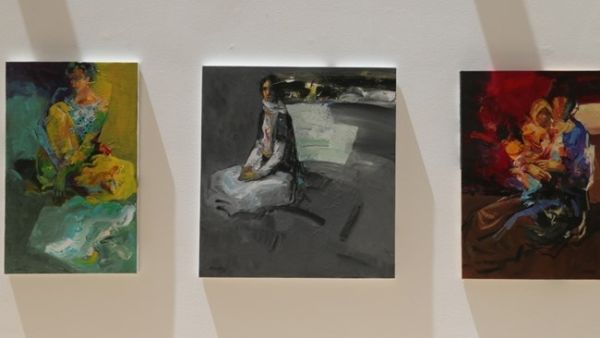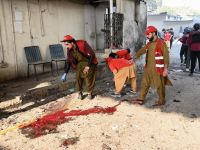Galerie Janine Rubeiz’s latest exhibition, Ahmad Kleige’s “Labyrinths of the Soul,” is a trip through beauty and pain.
These untitled acrylic-on-canvas works depict the artist’s experience as a Syrian refugee. Completed in the past two years, they are simply rendered but with a tumultuous character achieved by audacious brushstrokes and striking color palette.
Kleige told The Daily Star he had been fascinated by drawing since his childhood in Aleppo in the 1960s and ’70s.
He described himself as a “child tempted by colors and lines,” saying he “spent most of [his] childhood with paper and colors in hand.”
Although his access to art was limited, he was a voracious reader of the Syrian Education Ministry’s art magazine, whose focus on realism and impressionism greatly influenced his early work.
His first drawings were simple sketches of people and nature, but by the time he graduated from art school in Aleppo he’d begun to illustrate children’s magazines, of which the “most memorable,” he said, “was titled ‘Osamah.’”
His current series deals with the heavy subject of forced displacement. “It speaks for the simple people who were forced to leave their homes in fear of death,” he said, recalling the Kurds’ exodus from northern Iraq after the forces of Saddam Hussein launched a chemical weapons attack upon the Kurdish town of Halabja in 1988, killing 3,000-5,000 people, most civilians, and injured 7,000-10,000 more.
While not Iraqi himself, Kleige said his experience during Syria’s bloody civil war had made him empathetic to refugees of all stripes.
“I am still speaking for the plain human that was a victim of this violence tearing through my country,” he said.
Kleige’s draped figures are represented against monochromatic backgrounds of black and gray. They assume dejected or anguished postures, their brightly colored garments seeming to propel them from their dark surroundings.
Kleige’s brush style is typically heavy, with strokes often splattering or dripping onto one another, further evoking the turmoil that underpins his work.
“When violence reaches its peak and death becomes so widespread, souls are lost, in search for their salvation,” he said. “I tried to embody the helplessness that humans have reached, their quiet sorrow, their anticipation for the unknown.”
{"preview_thumbnail":"https://cdn.flowplayer.com/6684a05f-6468-4ecd-87d5-a748773282a3/i/v-i-8…","video_id":"84a1b66b-04f8-458c-9458-3a4527622703","player_id":"8ca46225-42a2-4245-9c20-7850ae937431","provider":"flowplayer","video":"2nd UK Navy Vessel Arrives in Gulf to Escort Trade Ships"}
This sorrow is evinced in his figures’ faces, many of which are obscured, turned away or abstractly depicted with a few brushstrokes. Some pieces in the show are portraits, brought to life by the same chaotic brushwork and vibrant colors of his figure pieces.
The artist’s persistent interest in the faces of his subjects, whether that entail detailed attention or conspicuous exclusion, is a long-standing one. His previous Beirut exhibition, “Shattered Faces,” staged six years ago, was composed exclusively of portraits like these.
Kleige traces his inspiration all the way back to his childhood attraction to color.
“I think that since the beginning I have had a fascination for the [folk] dresses of Kurdish women in the countryside,” he said, recalling “the embellishments of tapestry with all their bright colors and abstract shapes.” He admitted that “you can always see those influences in my works, taking me back to my childhood memories.”
The fact that Kleige’s passion as an artist originates in the helpless anguish of war makes his work all the more poignant. The kernel of innocence in his subject matter, though, offers some hope of redemption. “Through my search for beauty and my relationship with color, I had always tried to shine a light on innocent, plain humans, to be a voice they could share their pains and sorrows through,” he said. His hope is “to give them some of the divinity they have earned.”
“Labyrinths of the Soul” is up at Galerie Janine Rubeiz, Raouche, through Aug. 16.
This article has been adapted from its original source.








